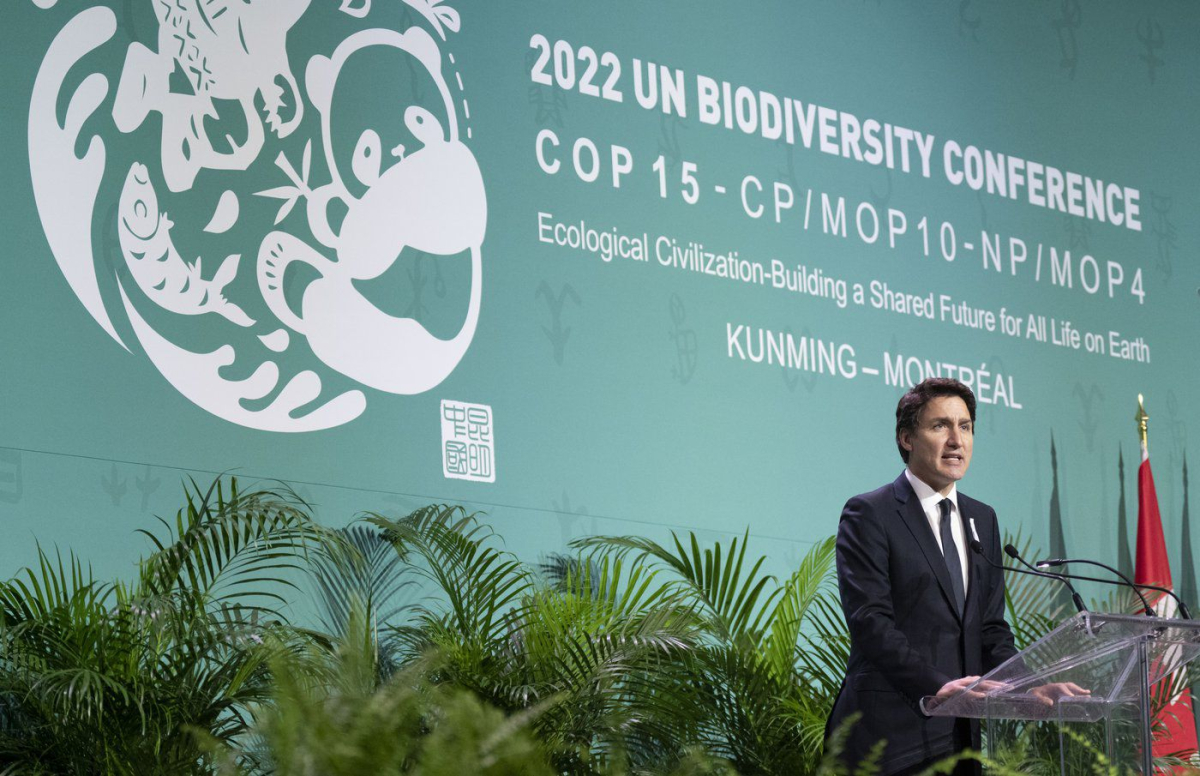Support strong Canadian climate journalism for 2025
Prime Minister Justin Trudeau was unequivocal Wednesday when asked if Canada was going to meet its goal to protect one-quarter of all Canadian land and oceans by 2025.
"I am happy to say that we are going to meet our '25 by 25' target," Trudeau said during a small roundtable interview with journalists on the sidelines of the nature talks taking place in Montreal.
That goal, which would already mean protecting 1.2 million more square kilometres of land, is just the interim stop on the way to conserving 30 per cent by 2030 — the marquee target Canada is pushing for during the COP15 biodiversity conference.
But what does the conservation of land or waterways actually mean?
"When we talk about protecting land and water, we're talking about looking at a whole package of actions across broader landscapes," said Carole Saint-Laurent, head of forest and lands at the International Union for Conservation of Nature.
The group's definition of "protected area," which is used by the UN convention on biodiversity, refers to a "clearly defined geographical space" that is managed by laws or regulations with the goal of the long-term protection of nature.
"It can range from areas with very strict protections to areas that are being protected or conserved," said Saint-Laurent.
"We have to look at that entire suite of protective and restorative action in order to not only save nature, but to do so in a way that is going to help our societies. There is not one magical formula, and context is everything."
The organization, which keeps its own global "green list" of conserved areas, lists 17 criteria for how areas can fit the definition.
Most of the criteria are centred on how the sites are managed and protected. One allows for resource extraction, hunting, recreation and tourism as long as these are both compatible with and supportive of the conservation goals outlined for the area.
In many cases, industrial activities and resource extraction are not allowed in protected areas. But that's not always true in Canada, particularly when it involves the rights of Indigenous Peoples on their traditional territory.
In some provincial parks, mining and logging are allowed. In Ontario's Algonquin Park, for example, logging is permitted in about two-thirds of the park area.
Canada has nearly 10 million square kilometres of terrestrial land, including inland freshwater lakes and rivers, and about 5.8 million square kilometres of marine territory.
As of December 2021, Canada had conserved 13.5 per cent of land and almost 14 per cent of marine territory. The government did it through a combination of national and provincial parks and reserves, wildlife areas, migratory bird sanctuaries, national marine conservation areas, marine protected areas and what are referred to as "other effective areas-based conservation measures."
These can include private lands that have a management plan to protect and conserve habitats, or public or private lands where conservation isn't the primary focus but still ends up happening.
Canadian Forces Base Shilo, in Manitoba, includes about 211 square kilometres of natural habitats maintained under an environmental protection plan run by the Department of National Defence.
The Nature Conservancy of Canada is a non-profit organization that raises funds to buy plots of land from private owners with a view to long-term conservation.
Mike Hendren, its Ontario regional vice-president, said that on such lands, management plans can include everything from nature trails to hunting — but always with conservation as the priority.
To hit "25 by 25," Canada must further protect more than 1.2 million square kilometres of land, or approximately the size of Manitoba and Saskatchewan added together. To get to 30 per cent is to add, on top of that, land almost equivalent in size to Alberta.
The federal government would need to protect another 638,000 square kilometres of marine territory and coastlines by 2025, or an area almost three times the size of the Gulf of St. Lawrence. By 2030, another area the size of the gulf would need to be added.
Trudeau said that in a country as big and diverse as Canada, hard and fast rules about what can and can't happen in protected areas don't make sense.
He said there should be distinctions between areas that can't have any activity and places where you can mine, log or hunt, as long as it is done with conservation in mind.
"There's ability to have sort of management plans that are informed by everyone, informed by science, informed by various communities, that say, 'yes, we're going to protect this area and that means, no, there's not going to be unlimited irresponsible mining going to happen,'" he said.
"But it doesn't mean that there aren't certain projects in certain places that could be the right kind of thing, or the right thing to move forward on."
The draft text of the biodiversity framework being negotiated at COP15 is not yet clear on what kind of land and marine areas would qualify or what conservation of them would specifically mean.
It currently proposes that a substantial portion of the conserved land would need to be "strictly protected" but some areas could respect the right to economic development.
This report by The Canadian Press was first published Dec. 9, 2022.




Comments